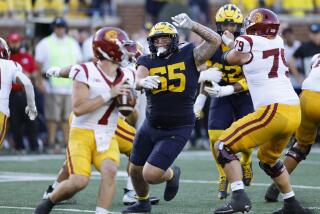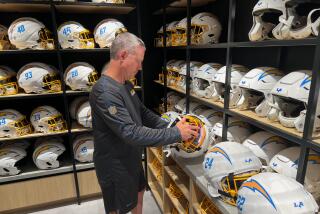The Daily Grind
- Share via
A number of well-chronicled deaths on high school, college and professional football practice fields this summer have caused such seemingly routine workouts to be scrutinized as never before. The question has been raised repeatedly in recent weeks: Is preseason football practice safe?
With that in mind, The Times asked Rob Huizenga, team doctor for the Raiders from 1983-90, to monitor a recent Sherman Oaks Notre Dame practice and to offer insight into the toll an average workout takes on a high school player.
Huizenga was asked specifically to observe Tim Volk, a 6-foot-3, 245-pound offensive and defensive lineman who has committed to play for Arizona next year.
Varsity football practice at Notre Dame begins at 5 o’clock sharp. It was another warm summer afternoon in the San Fernando Valley, but a cool breeze tempered the searing sun. There was little smog or humidity.
The Knights, some 50 strong, formed a tight circle around Coach Kevin Rooney to hear a few words of instruction before lining up in neat rows across the field to perform a set of 16 short jogs of about 40 yards apiece. In the next three hours, players of varying size, strength, experience and motivation would participate in a typical preseason practice.
Huizenga, now in private practice on the Westside, found many things he admired about Notre Dame’s workout, including the late starting time to avoid the heat of the day, frequent water and rest breaks and the superb condition of the school’s practice field. He found no glaring errors of judgment among the team’s coaching staff and athletic trainers.
At one point, when Volk went to the sideline to have his right ankle taped after twisting it during a drill, Huizenga termed the practice a “microcosm” of what one would hope to see at a typical workout. Volk would run slightly more than a mile--most of it during bursts of no more than five yards at a time--and crash into countless teammates. He also would join teammates in taking water and rest breaks roughly every 15 minutes. And he would lose between two and three pounds, weight he would regain after a hearty dinner.
What’s more, his ankle injury proved to be nothing that would prevent him from practicing the following day. “I have strong ankles,” the 18-year-old said in a defiant tone as the team’s trainer taped him.
Later, Huizenga would recall Volk’s comment and add, “You’re invincible at 17 or 18 years of age.”
*
As the players followed their jogging with a series of stretching exercises designed to prepare their muscles for the more strenuous activity to follow, Huizenga said, “You’ve got a wind today, and convection gets rid of the heat from the skin, lowering the body temperature.
“In California, there’s not a lot of heat stroke because there’s not a lot of humidity. You just don’t get it.”
The high temperature that day in nearby Van Nuys was 89; hot enough to be sure, but tolerable compared to recent days. Volk said an on-field thermometer spiked to 108 degrees during an afternoon workout three days earlier.
Heat and humidity have been blamed for the death of offensive lineman Korey Stringer of the Minnesota Vikings during a training camp workout in early August. They have also played a role in the deaths of several college and high school players during practices held this summer.
“In really muggy weather, in Florida [for example], you can sweat an extra half-liter of water,” Huizenga said. “You can get heat prostration if the [air] temperature is above 98.6 [normal body temperature].”
On this day, the weather won’t be much of a factor. But just in case, the players are never very far from water bottles. In fact, each has his own, with his uniform number clearly written on the side. In addition, there are two huge coolers on the sideline--one filled with cold water and another with Gatorade. Like clockwork, the players broke for water every 15 minutes or so. They are free to remove their helmets, which enables the breeze to whisk excess moisture from their heads, cooling the players. There are not allowed to sit or rest on one knee, however.
“Water is what you need to prevent heat stroke,” he said. “The thirst mechanism doesn’t kick in until you’ve lost 2 percent of your body weight, but you should still drink [at every opportunity]. There’s an argument going on now, a huge debate, really, over drinking water and sports drinks, over which is better for you.
“If you’re an ultramarathon runner, you need tons of salt and tons of sugar. For an hour-long game, you might need a little sugar and not a lot of salt. Cold water is probably more palatable.”
Because football players go about their business covered by heavy equipment, it’s often difficult for coaches and medical personnel to monitor the players’ health. When Huizenga worked with the Raiders, the team had a buddy system, with players pairing off to keep tabs on one another.
*
When stretching exercises were completed, the players broke into two groups. Volk and his fellow linemen moved to a blocking sled at one end of the field. Another group worked on drills designed to improve the team’s punt coverage. They did quite a bit of running, sprinting at up to 60 yards at a time.
Volk and the linemen did not exceed five yards at a time during their drills. They went at a maximum effort for five seconds against heavily padded sleds, but got almost 30 seconds rest while awaiting their next charge. “This is intermittent exercise,” Huizenga explained. “It’s high intensity with breaks.... Linemen are in a different world from running backs and defensive backs. They play on the same team, but in different parts of the football world.”
Linemen such as Volk need speed in short, powerful bursts of five to 25 yards. They explode from the line of scrimmage once the ball is hiked to the quarterback. They also need all the strength they can muster to fend off opponents.
They benefit most from over-the-counter performance-enhancing supplements such as Creatine, Huizenga said. One practice observer, who did not wish to be named, indicated that last season’s Notre Dame squad had several players who regularly took Creatine, but he doubted any members of the current squad did.
As practice rolled into its second hour, the sun began to cast long shadows across the field. So far, the workout seemed more tedious than taxing for Volk. Again and again, his activity had been limited to short bursts of energy--some as short as a second or two--followed by a rest period of 20 to 30 seconds.
Huizenga noticed the linemen had begun to perform a blocking drill, the first contact between the bigger players during this practice. At last, the popping sound of players’ shoulder pads crashing together could be heard on the field. Now, the risk of injury increases, although not as much as one might expect for Volk.
There is little evidence to suggest repeated collisions do any lasting physical damage to a high school lineman, but Huizenga said NFL players often suffer from long-term spinal damage.
“The biggest thing for an offensive lineman is charging off the line and having somebody fall on a knee or getting blocked illegally [from behind or below the waist],” Huizenga said.
As if on cue, another lineman grabbed hold of a teammate and sent him crashing into Volk’s lower right leg.
“He’s limping off his right leg,” Huizenga said. “Let’s see how long he stays out there.” Not very long. Volk hustled to get his ankle taped, missing more than a dozen plays during the scrimmage. “What’s the risk versus benefit here?” Huizenga wondered aloud. “He’s not taking himself out. The body has an alarm system, listen to it. But there’s an old saying that you can’t make the team from the hot tub. Is this a morale thing for the rest of the team because he’s the superstar and he’s staying out there? These are hard questions.”
Although he limped at the time, Volk continued playing that night. The injury, however, would keep him out of practice for nearly a week. He is expected to take the field Friday when Notre Dame plays at Lynwood.
“It is hard to assess an injury in the middle of all this,” Huizenga said. “This is why it’s [so difficult].... Think about the team doctors of high school football teams. They have only so much time to spend with the players [during preseason screenings].”
So the questions are quick and simple, Huizenga said. A sampling: Any chest pain? Ever fainted or come close to fainting? Any sudden death in your family history?
The doctor listens for heart irregularities and takes the player’s blood pressure, then it’s on to the next youngster. “Even if you are well trained, you probably only pick up 5 percent of the kids at risk of heart trouble,” Huizenga said. “It’s very tough. There are simply not enough well-trained sports medicine doctors to go around. Yet, when a [death] happens, it strikes a raw cord with people.”
*
The final hour of Notre Dame’s practice on this day was devoted to scrimmaging and conditioning. The sun had set. It turned out to be a pleasant evening.
But the Knights still had a ways to go before they could rest. Rooney and his assistants had waited until the coolest part of the practice to introduce the toughest elements.
The scrimmage continued and the players’ fatigue became obvious. Many players, including Volk, rested their hands on their hips between activity, an indication to Huizenga that they were growing tired. He also noticed many players’ chests were heaving, another sign they were working harder in the final hour of the practice.
Still, there were several other players who continued to engage in light-hearted banter. If they were , exhausted, Huizenga said, all casual conversation would cease. The body would not have sufficient energy.
At 7:35, Rooney signaled an end to the scrimmage and the players hooted and hollered. Now, in the darkness, they would perform one final task before hitting the showers, running 60-yard sprints at maximum effort. Volk was grouped with the squad’s bigger players--the linemen, the linebackers and tight ends. A second group was comprised of running backs, wide receivers and defensive backs. After 10 charges down the field, practice was history. The players gathered around Rooney, who gave them a few words of instruction before sending them home for the evening. For the first time, the players were allowed to sit.
Huizenga had hoped to see some sort of cool down after the hard sprints, perhaps a slow jog around the field. All in all, he was impressed by what he’d just seen. It was not dramatically different from what he used to witness in his years with the Raiders, but with one obvious difference.
“This is pure sport,” he said. “These guys are doing because it’s a dream, it’s a goal, to get the girl, to please the parents, to satisfy a dream inside them. It’s amazing, in adult conversation, how often you refer back to your high school football days. There is something special going on inside that huddle with the guys.
“People have an incredible sense of euphoria by just getting out and playing a game, and they’re willing to take risks.”
More to Read
Go beyond the scoreboard
Get the latest on L.A.'s teams in the daily Sports Report newsletter.
You may occasionally receive promotional content from the Los Angeles Times.










